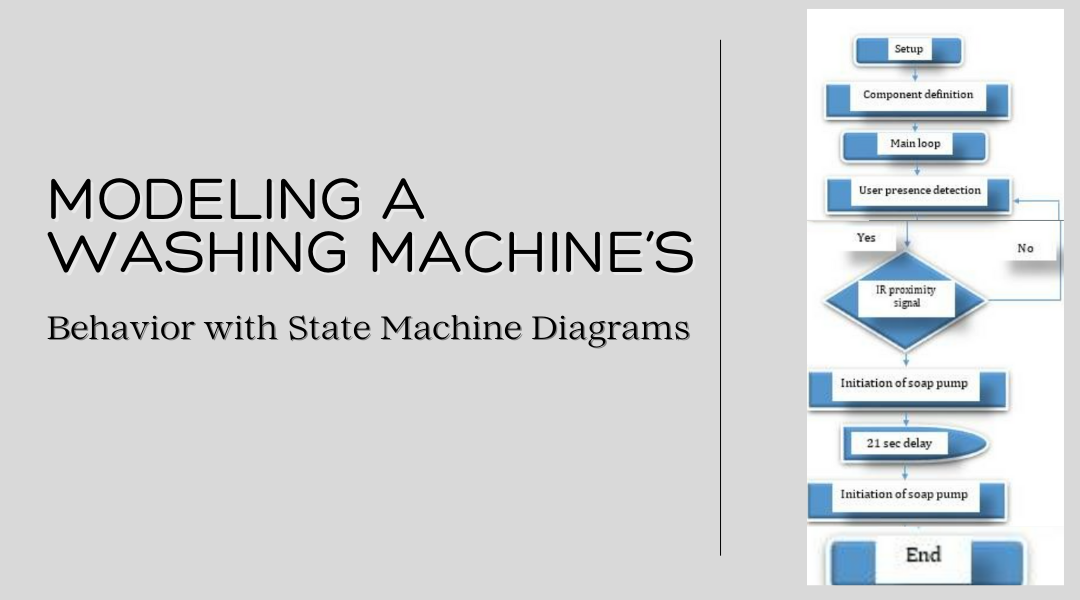Ever wondered how a washing machine knows when to switch from filling to washing, or from rinsing to spinning? Behind the hum of its motor and the slosh of water, there’s a well-defined sequence of states and transitions—like a carefully choreographed dance.
In systems engineering, we can map out this behavior using state machine diagrams, a powerful tool in SysML. These diagrams help us visualize how a system moves between different operational modes based on triggers, conditions, and actions.
Let’s break down how a typical washing machine operates, step by step, and model its workflow in a way that’s both intuitive and precise.
1. Mapping the Washing Machine’s Key States
First, we need to identify the machine’s primary operational phases:
- Idle: The machine is powered on but waiting for input—like a car parked with the engine running.
- Filling: Water pours into the drum until it reaches the right level.
- Washing: The agitator churns the clothes in soapy water.
- Rinsing: Dirty water drains, and fresh water flushes out detergent.
- Spinning: The drum whirls at high speed to wring out moisture.
- Completed: The cycle finishes, often signaled by a beep or an indicator light.
Each of these states represents a distinct stage in the wash cycle.
2. What Triggers the Transitions?
A washing machine doesn’t just guess when to move from one state to another—it responds to specific events and conditions:
- From Idle to Filling: The user presses Start.
- From Filling to Washing: A sensor confirms the water level is correct (WaterLevelReached).
- From Washing to Rinsing: A timer runs out (WashTimeElapsed).
- From Rinsing to Spinning: Another timer completes (RinseTimeElapsed).
- From Spinning to Completed: The spin cycle finishes (SpinTimeElapsed).
Without these triggers, the machine would either stall or malfunction—imagine it endlessly filling with water or never draining.
3. Adding Safety Checks with Guard Conditions
Sometimes, a transition should only happen if certain criteria are met. These are called guard conditions, acting like bouncers at a club—only letting the system proceed if everything checks out.
For example:
- Before moving from Filling to Washing, the machine verifies: [WaterLevel == Full].
- If the user skipped the rinse option, it might bypass Rinsing entirely.
These conditions prevent errors, like spinning while the drum is still full of water.
4. Actions: The Behind-the-Scenes Work
Every state change involves actions—small tasks that prepare the machine for the next step:
- Entering Filling: The water pump activates (StartWaterPump).
- Exiting Washing: The drain valve opens (DrainWater).
- Starting Spinning: The motor kicks into high gear (StartSpinMotor).
- Finishing the Cycle: A chime sounds (SignalCompletion).
These actions ensure smooth transitions, like a pit crew servicing a race car between laps.
5. Visualizing the Flow
Here’s how the entire process looks in a simplified state machine flow:
- Idle → (Start pressed) → Filling
- Filling → (Water full?) → Washing
- Washing → (Timer ends) → Rinsing
- Rinsing → (Timer ends) → Spinning
- Spinning → (Timer ends) → Completed
- Completed → (User resets) → Idle
Why This Matters in Real-World Design
Modeling systems this way isn’t just academic—it’s how engineers ensure reliability. If a washing machine glitches during development, a state machine diagram helps pinpoint where the logic failed. Did it skip rinsing? Did the spin cycle start too soon? The diagram makes troubleshooting systematic.
Beyond appliances, this approach applies to everything from traffic lights to medical devices. Any system with defined operational modes can benefit from a clear state-based blueprint.
Final Thoughts
Next time you load laundry, think about the hidden logic guiding your machine through each phase. What seems like a simple appliance is actually a finely tuned state-driven system—one that SysML helps us design, refine, and perfect.
By mastering state machine diagrams, engineers can build systems that behave predictably, efficiently, and safely—whether it’s a washing machine or something far more complex.
